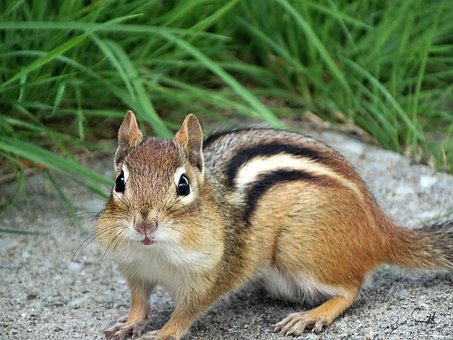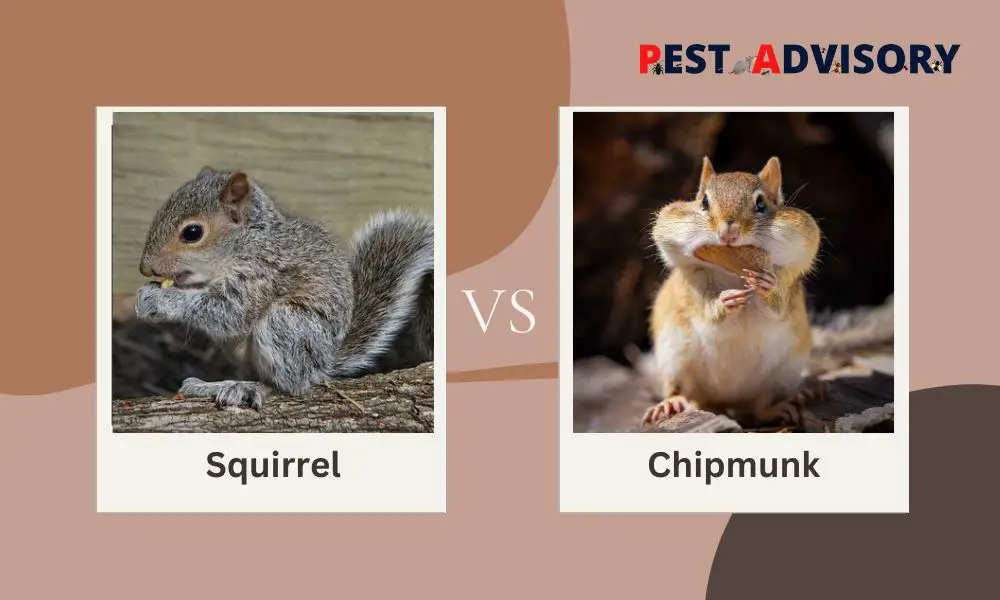Chipmunks are often confused with tree or ground squirrels. As a result, sometimes a solution for squirrel infestation is applied in case of chipmunk problems and vice-versa. This often leads to frustration and distrust of solutions.
But the problem lies in recognizing the pest that has infested your place.
So if you too are confused and tired of the ineffective solutions, read this article to clear your doubts about the pest you are dealing with.
Important Note: If you're tired of pests and want a reliable solution, then you should definitely consider seeking help from a professional pest control company. DIY solutions can be effective, but if you're dealing with a significant pest infestation, you don't want to rely solely on DIY methods. Pest control companies typically don't charge huge fees. You can fill out this form to receive free quotes from the top local pest control companies, and compare the quotes and see for yourself. Then, finally, your pest problems will be eliminated for good.
Is Chipmunk Related to Squirrels?
Though they may look similar at first glance, there are several key ways to tell a squirrel apart from a chipmunk. For one, squirrels are typically larger than chipmunks, with longer tails and legs. Additionally, while both animals have furry tails and striped fur coats, the stripes on a squirrel’s coat tend to be more subtle than those on a chipmunk’s. Finally, squirrels typically have brown or reddish-brown fur, while chipmunks usually have gray or tan fur.
Ways to Distinguish between Squirrels and Chipmunks
Squirrels and chipmunks are both small furry rodents who frequent our terraces and gardens quite often. They look almost similar to each other. They even resemble each other in their dietary habits and activities. Though some minute differences exist. These can be categorized in:
Appearance
Chipmunks have distinct stripes running down their entire bodies. Their tails are furry but not much bushy and heavy.
Tree squirrels on the other hand are comparatively larger and their bodies are devoid of any kind of stripes. Their tail is more prominent, longer, and bushier.
Ground squirrels are around the same size as chipmunks and they have stripes as well. But whereas the chipmunks have stripes all over, the ground squirrels do not have any stripes in their head area. They have stripes only on their body.
Diet
One way is by looking at their diets. Squirrels are mainly herbivores, while chipmunks are omnivores. This means that squirrels will mostly eat plants, nuts, and fruits, while chipmunks will also eat insects and small animals in addition to plants.
To know who has invaded your yard or garden, what you can do is leave some nuts and (if you can manage) some dead insects around. Nuts are an all-time favorite of squirrels, so they will go for it.
Whereas, there is a high chance that a chipmunk would bypass the nuts to go to the insect. If not flat-out rejection, you might see the chipmunk feeding on both foods.

Habitat
Squirrels are typically found in trees, while chipmunks live in burrows in the ground. This difference is due to the different food sources that these animals rely on. Squirrels eat mostly nuts and seeds, which they store in tree cavities for later use. Chipmunks, on the other hand, eat mostly insects and other small invertebrates. They also consume a lot of plant matter, including berries, leaves, and roots. Because of their different diets, squirrels, and chipmunks occupy different niches in the ecosystem.
| Squirrel | Chipmunk | |
|---|---|---|
| Appearance | Bushy tail, furry body | Striped back, furry body |
| Size | 6 to 15 inches (15-38 cm) | 5 to 6 inches (13-15 cm) |
| Weight | 0.5 to 1.5 pounds (227-680g) | 2 to 4 ounces (56-113g) |
| Lifespan | 5 to 10 years | 2 to 3 years (in wild) |
| Diet | Nuts, seeds, fruit | Nuts, seeds, fruit, insects |
| Distribution | Found in most parts of the world | Found in North America and Asia |
Nesting
The nest of red squirrels can be found in tree branches, hollows, and attics or terraces. These are just large dreys made out of leaves, branches, and straws. Ground squirrels usually burrow simple holes in your gardens.
Chipmunks on the other hand make special nests on the ground only. But they have elaborate burrow tunnels, places for food storage, and channels that aid them in emergency escape as well as give entry into your houses.
Thus, you will find them making entry points near the base of the houses, just above the foundation walls, and under the stairs or decks.
Activity
Squirrels and chipmunks are both crepuscular creatures. That means both works during the dawn and dusk hours. But their activity styles differ in the winter.
Towards the late autumn, squirrels eat as much as they can to make their bodies hefty and store fat and energy. Because during winter most of them go into hibernation mode.
Chipmunks do not completely hibernate during winter. So in late autumn, they start collecting and storing food in their elaborate nests. Their activity decreases in the winter but they manage to eat and live off of the food store.
How does it help you? Well if you see a rodent eating or gnawing the food lying around, especially in October or November, there is a high chance that it is a squirrel. If you see them running away with it, it might be a chipmunk.
Sounds Made
Both chipmunks and squirrels are extremely vocal. But the difference is that, in squirrels, the sound is a rapid series of bark-like alarms called “Kuk-Kuk”. Squirrel calls are often accompanied by a shake or flick of their tails. Other vocalizations by squirrels include moans, rattles, screeches, and aggressive tail thrashing.
Whereas chipmunks are known to produce cluck calls and high-pitched chirps.
Droppings
Squirrels’ excreta looks like jelly beans or raisins and is usually scattered all over.
Chipmunks’ feces look like mouse droppings. They are round and are found in clusters.
comparison table between squirrel vs chipmunk
How to Tell If a Squirrel or Chipmunk Is Visiting Your Yard
Assuming you’re in North America, there are a few key ways to tell these two animals apart. Generally, squirrels are larger than chipmunks and have proportionally longer tails. They also tend to be more agile, often leaping from branch to branch instead of running along the ground.
To get a closer look, try to observe the animals when they’re eating. Squirrels typically eat whole nuts, while chipmunks will strip the shells off before eating them. Also, chipmunks tend to hoard their food, caching it in their cheek pouches to take back to their burrows, whereas squirrels will bury their food for later.
If you’re still having trouble telling them apart, listen to their calls. Squirrels make higher-pitched “chattering” noises, while chipmunks produce a lower-pitched “trilling” sound.

Chipmunk vs Ground Squirrel
Chipmunks are slightly smaller than ground squirrels, with adult body lengths ranging from 4 to 6 inches. They also have stripes running down their backs and sides, whereas ground squirrels are solid brown or gray in color. Chipmunks also have longer tails relative to their body size than ground squirrels.
Another key difference is that chipmunks typically hibernate in wintertime, while ground squirrels do not. If you see a small rodent scampering around your yard in the middle of winter, chances are it’s a ground squirrel.
Finally, chipmunks are timider than ground squirrels and tend to avoid humans. If you see a small rodent running away from you as soon as you step outside, it’s probably a chipmunk.
Which One is Faster Chipmunk or Squirrel
Squirrels and chipmunks are both small, rodent-like animals that are commonly found in North America. They are both quick and agile, but which one is faster?
In a race, a squirrel would likely come out on top. Squirrels can run up to 20 miles per hour, while chipmunks top out at around 15 miles per hour. So if you’re ever being chased by either of these animals, your best bet is to make a run for it!
Reproduction in Squirrel vs Chipmunk
One of the biggest differences between these two animals is their reproduction. Squirrels generally reproduce once a year and have litters of two to eight babies. Chipmunks, on the other hand, reproduce multiple times per year and have litters of four to six babies.
Damage Caused by Squirrels and Chipmunks
Squirrels are mainly responsible for causing serious structural damage. They make entry points by chewing through walls and building materials. Ground squirrels are responsible for damaging your yards and gardens when digging holes for their burrows.
Chipmunks cause huge damage to your ornamental plants. They like berries and colorful seeds. So they are bound to attack your plants to harvest their food. This might tear and break delicate plant parts.
Reports have revealed that chipmunks have an affinity for spring flowering plants and are known to eat bulbs and seeds of these plants. Though they are not known to cause any structural damage.
How to Get Rid of Squirrels and Chipmunks
If you’re tired of squirrels and chipmunks raiding your bird feeders, raiding your garbage cans, and generally just making a nuisance of themselves, you’re not alone. Fortunately, there are a few things you can do to get rid of these pesky critters.
Remove Bird Feeders
One of the best ways to get rid of squirrels and chipmunks is to remove their food sources. If you have a bird feeder, make sure it’s squirrel-proof. There are a number of squirrel-proof bird feeders on the market that can keep these critters from getting to the bird seed.
Secure Garbage Cans
You should also secure your garbage cans so that they can’t get into them. Be sure to put tight-fitting lids on your garbage cans and keep them stored in a shed or garage if possible.
Trap Them
Another way to get rid of Chipmunks and Squirrels is to trap them. There are a number of different types of traps available, so be sure to do some research to find the best one for your need. Once you’ve caught a squirrel or chipmunk in a trap, you can then release it far away from your home so that it doesn’t come back.
Detter Them
Another way to get rid of squirrels and chipmunks is to deter them with noises. You can buy a device that emits ultrasonic sound waves at your local hardware store or online. These sound waves are high-pitched and only audible to animals, so they won’t bother you or your family.
Use Intense Scents
Spill peppermint oil, or leave garlic cloves or coffee beans around. Squirrels have sensitive noses and they cannot take intense scents.
Final Words
So look for all the telling signs of squirrel and chipmunk infestation while trying to deal with them. And when you are sure of which pest infestation you have, you can use the deterrents accordingly.
This way your money is saved from being wasted on wrong solutions. Also, with effective ousting of the pests now you can sigh in relief.
We hope this article could manage some of your frustrations!

